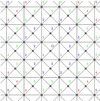issue contents
March 2021 issue

Cover illustration: Until recently, virtually all experimental electron densities have been determined using single-crystal data. In this issue, Svane et al. [Acta Cryst. (2021), A77, 85-95] show that powder diffraction data collected using the overlapped high-grade intelligencer setup (OHGI) at SPring-8, which uses 15 MYTHEN strip modules, can yield comparable electron-density information to that obtained using the Aarhus vacuum imaging-plate diffractometer (AVID). The cover image shows the static deformation densities (top row) and residual densities (bottom row) for urea, showing that multipole electron densities can be obtained from powder diffraction even without a dedicated setup.
scientific commentaries

advances
research papers
 access
accessfoundations
research papers
 access
access access
access

 journal menu
journal menu




























